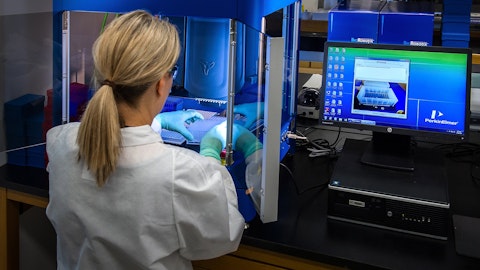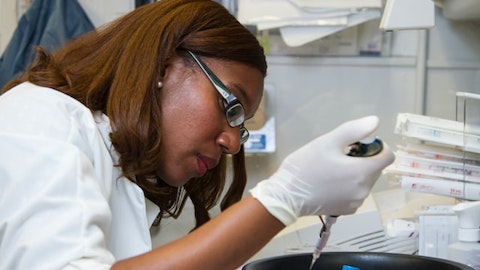Dr. Emily Leproust: Yes. So the initial feedback from RNA portfolio has been positive. We are seeing orders for people to test. And then from there, we will expect reorder and ramp. Stepping back to the IgG launch, frankly, it’s been average. The product for IgG is not quite highly differentiated. And so, we expect that the differentiation from fast gene is going to be greatly influencing the ramp. As you know, the more differentiated you are, the faster you run. So, we think fast gene will run faster. And as we make genes fast, we’ll be able to bring that benefit to IgG. And so we think that we could get a double benefit of not only having fast genes but also being able to improve the differentiation of our other products that are derived from genes. And so, our IgG are also going to accelerate in speed.
Operator: And our last question will come from Sung-Ji Nam with Scotiabank.
Sung-Ji Nam: Congrats on the quarter and to Jim on the next chapter. So, maybe on the — I had a question on the RNA sequencing portfolio, congratulations on launching that. Could you talk about kind of what the market potential there is relative to the DNA sequencing market and kind of what the current competitive landscape looks like?
Dr. Emily Leproust: Yes. Great question. So we think the market is probably about as the similar size, very different customers. On the DNA side, we are targeting diagnostic companies that are using our DNA to analyze samples and provide a clinical report. On the RNA, we are mostly going after academic customers. Although over time, I think RNA seq could go into the clinic. But right now, it’s mostly academic that we are targeting. The differentiation that we bring with our product on RNA seq is one a much faster workflow, so you can go from sample to sequence significantly faster with less hands-on time. And so, in academia, that is very useful. In a setting where maybe if it’s an automated setup, it doesn’t really matter or it matters less, but in academia and on time is key.
And then we also with our RNA Exome, we’re able to enable customers to significantly reduce the number of freeze that are wasted on part of the RNA sequence space that is not interesting, like housekeeping genes and tRNAs and so on. And so therefore, it lowers the cost per sample. And again, that’s a strong resonance with academia to lower the cost per sample. So those are the two differentiations. And we are a very late entrant in RNA seq, like we’re probably number 12, I guess, in the market. But in true discussion, [ph] we came in with some differentiation. And I think that’s going to enable us to take market share.
Sung-Ji Nam: Great. That’s super helpful. And then thank you for all the color on the Biopharma end market. Just curious for your liquid biopsy and MRD customers. Are you seeing relative stability from the funding or spending perspective for that segment of the market?
Dr. Emily Leproust: You want to take that?
Jim Thorburn: Yes, yes. So, I mean, NGS is going well. And we’ve got — building the pipeline NGS customers in terms of overall positioning, our customer saves in terms of sequencing costs significantly. So we continue to win and gain share. So overall, I mean we give our customers — I mean, we had a great value proposition, and we haven’t seen any significant issues. We continue to look forward to growth in that business, driven by increasing test volume and increasing adoption of liquid biopsy. And the number of customers that adopt us continues to increase. So, I mean I’m bullish on where we are with NGS. And it just reflects in my role as CFO, first year in NGS, our revenue was $3 million, now we’re $120 million.
And there’s more and more applications emerging. And as cost of sequencing comes down, it’s going to end up to be, I mean, a huge, huge opportunity for Twist and benefits the world as well. And yes, I’m excited about where we’re going to go.
Operator: Thank you. I’m showing no further questions in the queue. I’d like to turn it back to Emily Leproust for closing remarks.
Dr. Emily Leproust: Thank you very much for joining us today. We are driving towards adjusted EBITDA breakeven for the core business and see significant opportunities ahead. I am very excited — very exciting time at Twist, and I look forward to reporting our progress in the months ahead. Thank you very much for joining.
Operator: This concludes today’s conference call. Thank you for participating. You may now disconnect.
Follow Twist Bioscience Corp (NASDAQ:TWST)
Follow Twist Bioscience Corp (NASDAQ:TWST)
Receive real-time insider trading and news alerts




